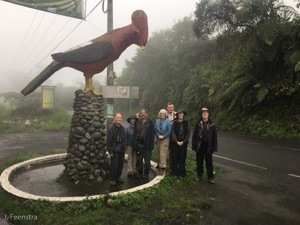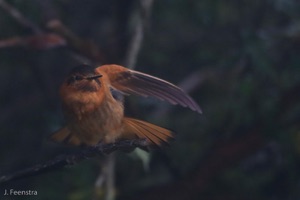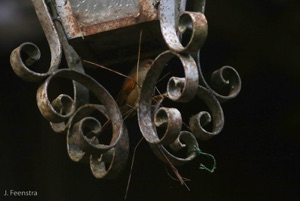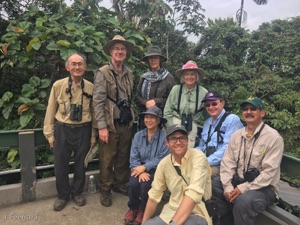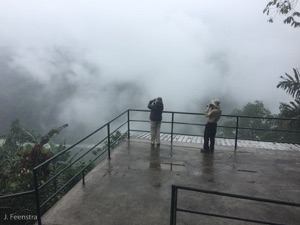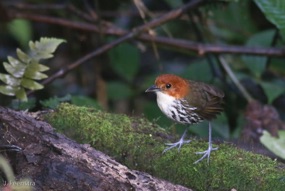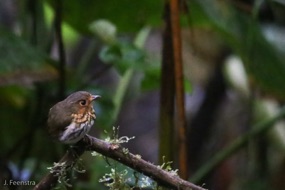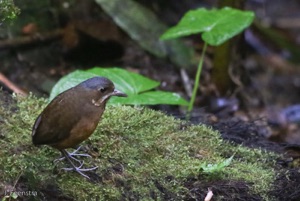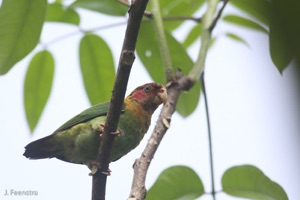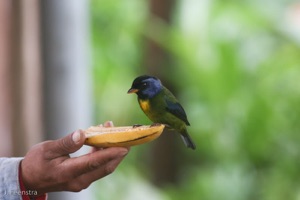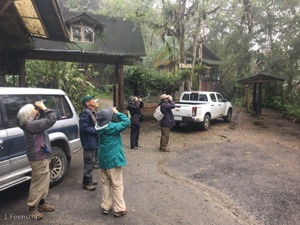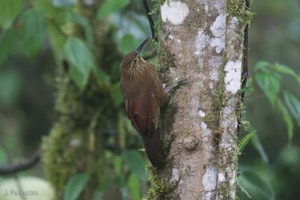This narrative is adapted from the account I wrote for the WINGS website HERE, but this one has photos!
The gang: Lilian, Steve, Frances, Phil, Stephen, Elizabeth, Mark, Jon (bird guy), Edwin (el conductor)
For a “one-stop-shop” of tropical birding, the Mindo area of northwest Ecuador is hard to beat. The rugged topography of the Andes, the micro-climates, and the moisture make the birdlife incredibly diverse for such a small area and perfect for daytrips from a central location.
In our week of ups and downs and arounds of the mountains we saw 35 species of hummingbird, dozens of tanager species, and many of the species endemic to the Chocó region shared by northwest Ecuador and southwest Colombia. Some of our most spectacular and memorable encounters were with Sword-billed Hummingbird, Rufous-gaped Hillstar, Toucan Barbet, Andean Cock-of-the-rock, White-tailed Trogon, Chestnut-crowned Antpitta, Orange-breasted Fruiteater, and Glistening-green Tanager. Those were only a few of the great things we saw and experiences we had while birding this magical place.
We started the morning (after a fight through Quito morning rush-hour traffic) birding the high
elevation reserve at Yanacocha on the slope of the Pichincha volcano. Here, the primeval forest with its enormous Gunnera leaves and hanging moss looks like something that could be hiding dinosaurs. There is usually a pretty nice view, too, but the fog was thick this morning. Nevertheless we found most of the typical birds including striking Scarlet-bellied Mountain-Tanagers, noisy Andean Guans, and lots of both Glossy and Masked Flowerpiercers. The hummingbirds were really the best, though. In addition to the impossibly-proportioned
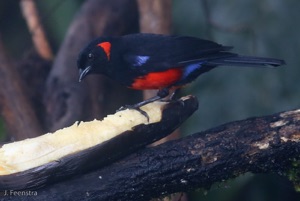
Sword-billed Hummingbird, we also saw a few huge Great Sapphirewings, and puffy pufflegs, both Sapphire-vented and Golden-breasted. After the morning there and a hot lunch, we descended in elevation by nearly two thousand meters passing through various grades cloud forest. Along the way we found Red-crested Cotinga, a Masked Trogon on the powerlines, and a couple of White-capped Dippers in the rushing stream. We ended at our lodge just outside of Mindo where we would be stationed for the next six nights.
The following morning we basically just rolled out of bed and started birding. The hotel is situated in a large forest reserve and it didn’t take us long to rack up a good total of birds
including some cloud-forest specialties like Spotted Woodcreeper, Zeledon’s Antbird, and One-colored Becard. The tanagers and hummingbirds are really what it’s all about here, though. The feeders by the front porch had diminutive Booted Racket-tails among the fourteen other hummingbird species, and right overhead in the fruiting trees were the likes of Golden Tanager and Beryl-spangled Tanager. We visited a bird-feeding station not far from the lodge and enjoyed a tanager bonanza including a
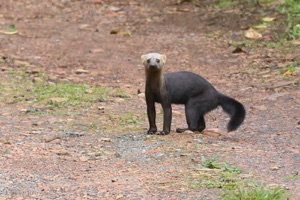
flock of mountain-tanagers with both Blue-winged and Black-chinned Mountain-Tanagers eating bananas and bathing in the fountain. The Flame-faced Tanagers were pretty nice, too, brighter next to other bright things. In the afternoon the clouds rolled in and we went down in elevation to the Milpe Reserve. We got our last new hummingbird of the day, the tiny Green Thorntail (of which there were lots) as well as some other lower elevation species like Collared Araçari (in a nest hole), Cinnamon Becards, and another gaudy one, Bay-headed Tanager.
A day in the lowlands is always a shock to the system, and a must on the itinerary. It’s hot,
it’s sticky, it’s buggy, and there are gobs of birds, often in crazy pulses where having extra eyes, arms, and pairs of binoculars would be very useful. We spent over three hours on the tower at the Rio Silanche Reserve as birds worked the canopy around us. We had some fancy lowland tanagers like Scarlet-browed, Tawny-crested, Golden-hooded, and Blue-whiskered. We also got to see close-up perched Blue-headed and Bronze-winged Parrots, at one point perched on adjacent branches.
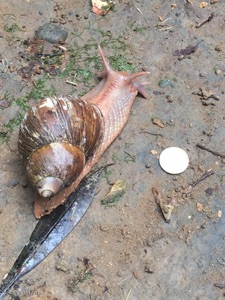
Two White-tailed Trogons thought we were pretty interesting during all of this and perched confidingly in various places around the tower. Though not as flashy as the many of the others, we had nice looks at Dot-winged Antwrens and it was a change of pace to be looking down at something. All the while a pair of Masked Tityras attempted to build a nest in a tree cavity, bringing in sticks that were far too large for the hole, but kept going, not giving in to such domestic frustration. After most of the day we left the lowlands for our higher, cooler climes with a stop along the way for some cold drinks on a porch with hummingbird feeders and occasional views of the river far below.
The next day we went higher into the mountains, did a little a battle with some weather, but with some patience and strategic visits to roof-covered refuges with bird feeders we did alright. From the back deck at Pacha Quindi we enjoyed quite a show as tanagers and others
visited a bank of fruiting trees. We saw a couple of bizarre and spectacular Toucan Barbets, a little marauding horde of Crimson-rumped Toucanets, and multiple of each of Golden-naped Tanager, Black-capped Tanager, Metallic-green Tanager, and Blue-capped Tanager. The hummingbird feeders had a spectacular Rufous-gaped Hillstar among 15 other species that also included Violet-tailed Sylph and Empress Brilliant. Coming back down out of the mountains we pulled over for a small group of Plate-billed Mountain-Toucans, just to make sure we got to see the bird that’s on the cover of the field guide.
There cannot be a visit to the Mindo area of northwest Ecuador without a visit to Reserva Paz de las Aves, and that was the focus of our next day. Here, birding celebrity Angel Paz, has transformed his farm and forest into a unique birding tourist attraction. The day began with one of nature’s great spectacles – half a dozen male Andean Cocks-of-the-rock screeching at their display lek in the trees above us. Then, Angel leads us around his property for the
antpitta show. He whistles, calls their names: “Cariño! Susanita! Willy! Shakira!” throws some worms out there on the ground, and these mythical, secretive, deep-forest birds pop out of the mossy depths and show themselves. We saw Chestnut-crowned, Yellow-breasted, Moustached, and Ochre-breasted Antpittas. Truly amazing and his extraordinary efforts highlight how difficult many of these birds are to see out in the forest.
Our next day was to the forest around the Mashpi Conservation Area. Though it looks the
same as a lot of the cloud forest we’ve been puttering around in all week, it is awash with local specialties. Birds that are rare elsewhere are somehow common here. We walked the dirt road with dense forest on each side of us. A Moss-backed Tanager perched on a vine nearly too close to photograph. The first Orange-breasted Fruiteater was shocking, and we ended up seeing about five more. We even saw a few of the extremely local Indigo Flowerpiercers. The feeders at Reserva Amagusa brought in a few more things and we saw Glistening-green Tanagers, Black-winged Saltators,
Crimson-rumped Toucanets, and others stuffing themselves with bananas. After leaving there we did a little birding at lower elevations along the road, however rain and a land slide turned us back (though we still saw some Gray-and-gold Tanagers) and we instead got ice cream and had our pictures taken in front of the big Andean Cock-of-the-rock monument outside of Mindo. So, it all worked out.
On our final day out we went back up into the higher elevation cloud forest. The plan was to walk one of the quiet roads picking up a few of the birds we missed on our previous day up
there. It was raining pretty steadily, though, so after we had driven all the way up there and gauged the situation, we took shelter in the parking area and patio of Bellavista lodge. It was better than expected. The lights around the parking lot attracted some of the insectivores that we would have looked for in the forest, and we got great looks at Russet-crowned Warblers, Cinnamon Flycatchers, and White-tailed Tyrannulets as they feasted on moths and such.
A Strong-billed Woodcreeper poked around picking insects off of lamp posts. The Masked Trogon hopping around on the ground eating bugs was particularly strange. We even got decent looks at a Spillmann’s Tapaculo that skittered between patches of flowers to grab little insect tidbits. After all of that, we did still get into the forest, saw Gorgeted Sunangel, a Streaked Tuftedcheek, a few more Masked Trogons, and a Plate-billed Mountain-Toucan.
Then we left. It was time to wrap it up. We left the cloud forest, passed back into the central Andean Valley, back into the crush of traffic and human noise away from the closeness of the forest. It’s an abrupt transition and hard to imagine that our entire week was only inside a circle of about 25 kilometers. We had an amazing week with some of the neo-tropics most special birds and iconic scenery and spectacles (Andean Cock-of-the-rock?!). Even so, there is always more and the week went by so fast!
(Want to see the photos and crowd-sourced identifications of the non-birds? Check out my iNaturalist entries from this tour by clicking HERE.)

